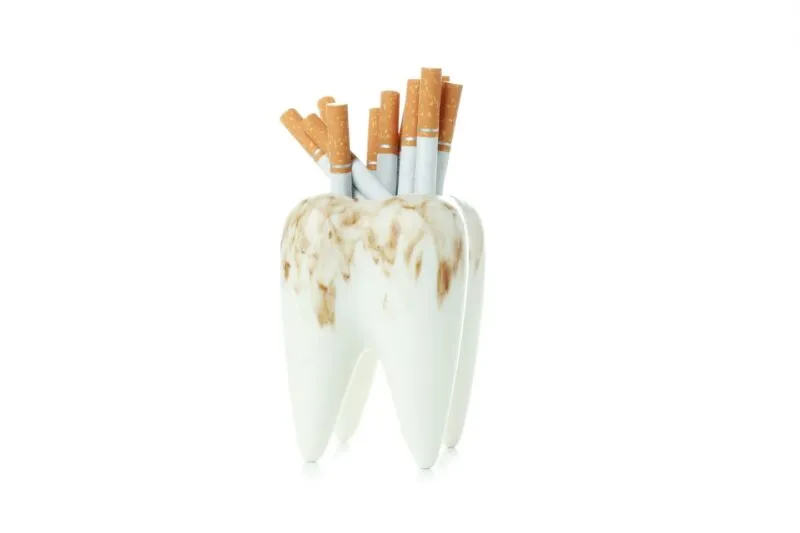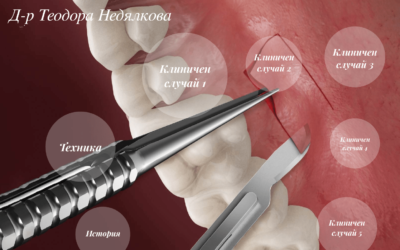Even children know that cigarettes are among the greatest enemies of health. It’s even written on the packs. Unfortunately, this doesn’t seem to deter those addicted to tobacco. Why are cigarettes so dangerous? And more specifically – how do they harm our oral health?
In May, when we mark World No Tobacco Day (May 31), we speak with the experienced dental medicine and periodontology specialist, Dr. Teodora Nedialkova, from the “Dr. Teodora Nedialkova” clinics in the capital. She graduated from the Faculty of Dental Medicine at the Medical University of Sofia in 2005, and in 2016, she earned a specialty in “Periodontology and Oral Surgery” under the guidance of Associate Professor Kamen Kotsilkov. Dr. Nedialkova has attended numerous master courses and training sessions in periodontology and implantology in Italy, France, Germany, Hungary, South Korea, Denmark, and Bulgaria. She is a member of the Bulgarian Dental Association as well as the societies for periodontology, gnathology, and occlusodontics.
“In tobacco smoke, there are at least 70 of the most dangerous carcinogenic substances – such as lead, cadmium, nickel, chromium, arsenic, polonium, beryllium, and others. It has been proven that a smoker consuming one pack of cigarettes per day receives in one year a dose of radiation equivalent to 1,000 X-rays!” warns Dr. Teodora Nedialkova.
Thus, it’s no surprise that this insidious habit triggers lung and cardiovascular diseases, cancer, diabetes, and infertility. It also leads to numerous oral diseases such as periodontitis or mucosal neoplasms, the dental specialist adds.
A paradise for infections
“Tobacco smoke not only causes changes at the cellular level but also generates free radicals that most actively affect the oral cavity, upper respiratory tract, and lungs, causing inflammation and mucosal atrophy,” notes Dr. Nedialkova. However, that’s not all.
“When a cigarette burns, extremely high temperatures are generated, damaging the epithelial layer of the respiratory tract and oral cavity, while also creating a favorable environment for the development of various infections,” warns the periodontologist.
She also highlights the effect of nicotine: “The International Agency for Research on Cancer does not classify it as a carcinogen, but it aids in the progression of malignant processes,” Dr. Nedialkova points out.
The smoke kills the cells
When it comes to periodontitis, there is no doubt – smoking is a definite risk factor. “Studies show that smokers are more prone to tooth and bone loss, the formation of periodontal pockets, and gum recession compared to non-smokers. Tobacco smoke affects the entire tooth-supporting apparatus at the cellular level, leading to cellular apoptosis (cell death). It also provenly suppresses immune defense, which worsens the inflammatory response and, consequently, may lead to damage and destruction of the alveolar bone,” reveals the dental specialist.
The gums may not bleed, but they are suffering
The numbers are telling – smokers are four times more likely to develop periodontitis. Additionally, the risk of developing a severe form of the disease is much higher. “Since their immune-inflammatory response is impaired, their periodontitis is characterized by less pronounced clinical signs,” shares Dr. Nedialkova. What does this mean?
“Their gums bleed less often, even though the depth of the periodontal pockets is very large. In smokers, the diameter and density of the capillaries in the gingival tissues are proven to decrease, which explains the reduced bleeding in this group, the less pronounced redness of the tissues, as well as the extremely poor response of the immune system in the oral cavity,” explains the periodontologist.
“Their response to non-surgical anti-infectious therapy is poorer, and low success rates have been reported for surgical procedures such as bone or soft tissue grafts and dental implant placements,” adds Dr. Nedialkova, who has extensive experience and several specializations in the field of implantology.
Wounds heal more slowly
Nicotine causes vasoconstriction – the narrowing of blood vessels, which worsens the healing of wounds in the oral cavity. “This is why in the latest classification of periodontal and peri-implant diseases and conditions from 2017, smoking has rightfully been taken into account and included as a diagnostic criterion, determining a higher risk class for periodontitis,” notes the dental specialist.
Dr. Nedialkova clarifies that the pathological effect also depends on the “dose” and the degree of nicotine dependence, which is classified as follows:
- Risk class “A” – non-smokers;
- Risk class “B” – smoker with up to 10 cigarettes per day;
- Risk class “C” – smoker with more than 10 cigarettes per day.
Cavities are more common
Do smokers suffer from cavities more often? “The correlation between the two has been the subject of hundreds of studies and meta-analyses over the years. Despite the many and varied methods used, the conclusion is clear – there is a connection between smoking and dental caries. Nicotine affects the oral bacteria that cause it by stimulating the growth of their colonies,” Dr. Nedialkova is adamant.
And that’s not all. “Nicotine reduces the amount of saliva produced, which increases the risk of developing cavities as well as bad breath,” the periodontist also points out.
The negative effect of cigarettes on the oral cavity is literally instant. “It’s important to know that even a week of smoking worsens oral health,” Dr. Nedialkova does not hide. Long-term dependence is even more devastating. “A man who smokes loses 2.9 teeth every 10 years of his life, while women lose slightly fewer – 1.5 teeth in the same period,” gives an example the dental specialist.
When is the effect of quitting visible?
A brilliant smile, as expected, is harder to achieve for cigarette lovers. “When several years pass since the start of smoking, yellow, brown, gray, to black spots can be seen on the enamel of the teeth, and in heavy smokers, even on the gums. Cleaning the tartar, plaque, and polishing the teeth in these individuals needs to be done almost twice as often compared to non-smokers,” shares Dr. Nedialkova.
The good news is that quitting smoking gives a beneficial effect relatively quickly. “If the patient stops smoking, the restoration of normal blood supply, size, and density of the capillaries happens between 6 and 36 months, and melanosia – the darkly colored gingival tissue – also fades after this period. However, the stains on the teeth must be removed through professional oral hygiene in the dental office,” clarifies the specialist from the “Dr. Teodora Nedialkova” clinics.
The risk of oral cancer is 10 times higher
We all know that cigarettes cause cancer. But not only in the lungs. “Smokers have a 10 times higher risk of developing neoplasms in the oral cavity compared to non-smokers. Genetic changes occur in the cells of the oral mucosa, which can lead to the disease,” says the periodontist.
“Not only smokers of conventional cigarettes are at risk, but also those who smoke cigars, pipes, e-cigarettes, heated tobacco products, as well as smokeless tobacco users. One must monitor for the appearance of erosions, ulcers – small sores, redness, fissures, and plaques that do not heal after more than 25 days. These can be observed on the lips, buccal mucosa, tongue, floor of the oral cavity, gums, and palate,” reveals Dr. Nedialkova.
Harmless cigarettes are a mirage
Are the so-called smokeless alternatives safer? “Tobacco heating devices have become very popular in Bulgaria in recent years and their use is growing rapidly. Their advertising is based on the fact that due to the lack of combustion, some of the harmful effects are reduced, and it has been proven that this is the case to some extent. But they also contain carcinogenic ingredients, although the manufacturing companies insist that they have been reduced,” notes the periodontist. “We are still waiting for new clinical studies on this topic so that their claims can be proven. So far, research has shown that the aerosol from the so-called smokeless cigarette contains substances obtained from pyrolysis. And during their thermogenic degradation, tar, nicotine, formaldehyde, acrolein, acetaldehyde, nitrosamines are released, which are potentially dangerous to human health. “Both conventional and smokeless cigarettes reduce the amount of saliva produced, but to a lesser extent than “regular” cigarettes. However, this can still lead to a decrease in oral pH, candidiasis, and halitosis (fungal growth and bad breath),” the dentist reveals the data from recent studies.
“Either way, harmless cigarettes have not yet been invented. Clinical studies regarding the new models on the market are ongoing, and until then, attempts to break free from this harmful and increasingly costly habit are worth it!” concludes Dr. Teodora Nedialkova.
Together with BETTY






